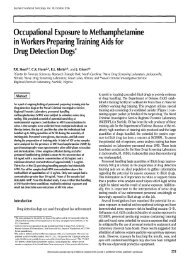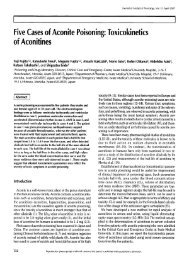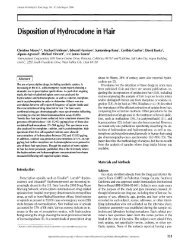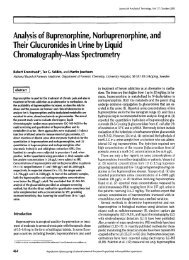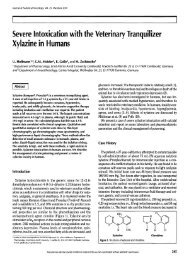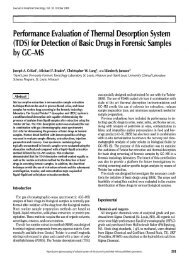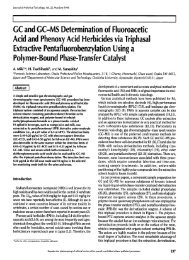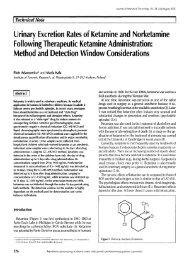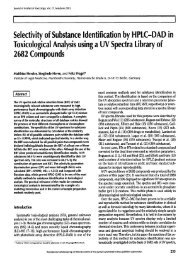Nontricyclic Antidepressants - Journal of Analytical Toxicology
Nontricyclic Antidepressants - Journal of Analytical Toxicology
Nontricyclic Antidepressants - Journal of Analytical Toxicology
You also want an ePaper? Increase the reach of your titles
YUMPU automatically turns print PDFs into web optimized ePapers that Google loves.
<strong>Journal</strong> <strong>of</strong> <strong>Analytical</strong> <strong>Toxicology</strong>, Vol. 31, July/August 2007<br />
Simultaneous Determination <strong>of</strong> <strong>Nontricyclic</strong><br />
<strong>Antidepressants</strong> in Human Plasma by Solid-Phase<br />
Microextraction and Liquid Chromatography (SPME-LC)<br />
Bruno los~ Gon~;alves Silva 1, Regina Helena Costa Queiroz 2, and Maria Eug~nia Costa Queiroz 1,*<br />
1Departamento de Qufmica, Faculdade de Filos<strong>of</strong>ia Ci~ncias e Letras de Ribeir~o Preto, Universidade de S~o Paulo,<br />
Ribeir~o Preto 14040-901, SP, Brasil and 2Laborat6rio de Toxicologia, Faculdade de Ci~ncias Farmac~uticas de Ribeir~o Preto,<br />
Universidade de S~o Paulo, Ribeir~o Preto 14040-901, SP, Brasil<br />
I Abstract I<br />
A sensitive, seledive, and reproducible solid-phase<br />
microextraction and liquid chromatographic (SPME-LC) method<br />
for simultaneous determination <strong>of</strong> mirtazapine, citalopram,<br />
paroxetine, fluoxetine, and sertraline in human plasma was<br />
developed, validated, and further applied to analyze plasma<br />
samples obtained from patients with depression. Important factors<br />
in the optimization <strong>of</strong> SPME efficiency are discussed, including the<br />
fiber coating, extraction time, pH, ionic strength, influence <strong>of</strong><br />
plasma proteins, and desorption conditions. The limit <strong>of</strong><br />
quantitation <strong>of</strong> the nontricyclic antidepressants in plasma varied<br />
from 25 to 50 ng/mL with a coefficient <strong>of</strong> variation lower than 5%.<br />
The response <strong>of</strong> the SPME-LC method for most <strong>of</strong> the drugs was<br />
linear over a dynamic range <strong>of</strong> 50 to 500 ng/mL, with all <strong>of</strong> them<br />
having correlation coefficients greater than 0.9970. The<br />
performance <strong>of</strong> the SPME-LC method allowed the nontricyclic<br />
antidepressants analyses in therapeutic levels.<br />
Introduction<br />
Depression is one <strong>of</strong> the most common <strong>of</strong> all major psychi-<br />
atric illnesses. The antidepressants, selective serotonin<br />
reuptake inhibitors (paroxetine, fluoxetine, citalopram, and<br />
sertraline), and an antagonist <strong>of</strong> central (x~-adrenergic autore-<br />
ceptors (mirtazapine) have fewer cardiovascular and anti-<br />
cholinergic adverse effects than the tricyclic antidepressants.<br />
Many nontricyclic antidepressants are potent inhibitors <strong>of</strong><br />
several different isozymes <strong>of</strong> the cytochrome P450 family<br />
<strong>of</strong> enzymes, and when these drugs are given simultaneously,<br />
they may mutually influence their biotransformation. In such<br />
* Author to whom correspondence should be addressed: Maria Eug~'nia Costa Queiroz,<br />
Departamento de Quimica, Faculdade de Filos<strong>of</strong>ia Ci6ncias e Letras de Ribeir~o Preto,<br />
Universidade de S~o Paulo, Bandeirantes Avenue, 3900, 14040-901, Ribeir~o Preto, SP,<br />
BrasiL E-mail: mariaeqn@ffclrp.usp.br.<br />
cases, the risk <strong>of</strong> overdosing and adverse effects should be con-<br />
sidered, and a laboratory measurement <strong>of</strong> plasma levels be-<br />
comes necessary. Understanding the similarities and differ-<br />
ences in the pharmacology <strong>of</strong> these drugs can guide the<br />
clinician to an optimal use <strong>of</strong> this important class <strong>of</strong> antide-<br />
pressants (1,2).<br />
Several chromatographic methods that require complex iso-<br />
lation procedures to improve the sensitivity and specificity <strong>of</strong><br />
the assay by removing any interference from the matrix while<br />
concentrating the analyte, such as liquid-liquid extraction,<br />
have been developed for the determination <strong>of</strong> nontricyclic an-<br />
tidepressants in plasma and serum (3-5). Solid-phase mi-<br />
croextraction (SPME), which was introduced by Pawliszyn and<br />
co-workers in 1990, is an alternative to the previously de-<br />
scribed classical method, which incorporates sample extrac-<br />
tion, concentration, and sample introduction into a single pro-<br />
cedure. SPME is defined as an extraction technique where the<br />
volume <strong>of</strong> the extracting phase is very small in relation to the<br />
volume <strong>of</strong> the sample and the extraction <strong>of</strong> analytes is not ex-<br />
haustive. The extraction efficiency is determined by the parti-<br />
tioning <strong>of</strong> the analyte between the sample matrix and the ex-<br />
traction phase. The partitioning is controlled by the<br />
physiochemical properties <strong>of</strong> the analyte, the sample matrix,<br />
and the extraction phase (6). SPME has been successfully ap-<br />
plied to analyze drugs in biological samples, mainly by coupling<br />
with gas chromatography (SPME-GC), and this has been the<br />
subject <strong>of</strong> several reviews (7-10).<br />
SPME has been introduced for direct coupling with liquid<br />
chromatography (LC) or LC-mass spectrometry (MS) in a<br />
small volume desorption interface (10) or <strong>of</strong>f-line LC desorp-<br />
tion (11-13) in order to analyze a wide variety <strong>of</strong> compounds,<br />
especially for the determination or identification <strong>of</strong> thermally<br />
unstable, low to nonvolatile, or very polar compounds not<br />
amenable to GC or GC-MS.<br />
In this manuscript, a simple <strong>of</strong>f-line SPME-LC method was<br />
developed and validated for simultaneous analyses <strong>of</strong> fluoxetine,<br />
Reproduction (photocopyinR) <strong>of</strong> editorial content <strong>of</strong> this journal is prohibited without publisher's permission. 313
paroxetine, citalopram, mirtazapine, and sertraline in human<br />
plasma. SPME variables that affect the extraction efficiency<br />
were optimized, and the influence <strong>of</strong> the fibers coatings and<br />
plasma proteins were investigated. The SPME-LC was further<br />
applied to analyze plasma samples from elderly depressed pa-<br />
tients.<br />
Material and Methods<br />
Reagents and analytical standards<br />
Fluoxetine and paroxetine analytical standards were kindly<br />
donated by Lilly (S~o Paulo, Brazil) and Libbs (S~o Paulo,<br />
Brazil), respectively. Citalopram, mirtazapine, and sertraline<br />
were donated by Roche (S~o Paulo, Brazil), and clomipramine<br />
(internal standard) was donated by Pfizer (S~o Paulo, Brazil).<br />
The working standard drug solutions, based on interval con-<br />
centrations, were prepared by diluting the stock solutions <strong>of</strong><br />
these drugs (1 mg/mL in methanol) to a proper methanol<br />
volume. These solutions were stable for 45 days when the tem-<br />
perature was kept at -20~ The water used to prepare the<br />
mobile phase was previously purified in a Milli-Q system (18<br />
mega ohm) (Millipore, S~o Paulo, Brazil). <strong>Analytical</strong> grade<br />
sodium chloride (Merck, $5.o Paulo, Brazil) was used after<br />
purification by heating at 300~ overnight. Methanol and<br />
acetonitrile (both high-performance liquid chromatography<br />
grade), hydrochloric acid, and acetic acid were obtained from<br />
J.T. Baker (Phillipsburg, N J). Monobasic and dibasic phosphate,<br />
sodium borate, and sodium acetate were purchased from Merck<br />
(Darmstadt, Germany).<br />
Plasma samples<br />
Plasma from healthy volunteers not subjected to pharma-<br />
cological treatment for at least 72 h (blank plasma) was gently<br />
supplied by the Hospital das Clfnicas de Ribeir~o Preto (Uni-<br />
versity <strong>of</strong> S~o Paulo, Brazil). This plasma was used for the<br />
SPME-LC method validation.<br />
The plasma samples were colleted from patients subjected to<br />
therapy with nontricyclic antidepressants for at least two<br />
weeks. Blood samples were drawn 12 h after the last drug ad-<br />
ministration. The principles embodied in the Helsinki Decla-<br />
ration were adhered to, and the Ethics Committees at the Uni-<br />
versity <strong>of</strong> S~o Paulo in Ribeir~o Preto, Brazil approved the<br />
study.<br />
SPME equipment<br />
The SPME holder, the fibers coated with polydimethyl-<br />
siloxane (PDMS, 100-pro film thickness), polydimethyl-<br />
siloxane/divinylbenzene (PDMS/DVB, 65-pm film thickness),<br />
the carbowax/templated resin (CW/TPR-100, 50-pm film thick-<br />
ness), and the carbowax/divinylbenzene (CW/DVB, 65 pm film<br />
thickness) were all obtained from Supelco (S~o Paulo, Brazil).<br />
The virgin fibers were conditioned by immersion into methanol<br />
for 30 min and dried prior to use.<br />
Instrumentation<br />
The LC system used was a Pro Star Varian (model 230, CA)<br />
314<br />
<strong>Journal</strong> <strong>of</strong> <strong>Analytical</strong> <strong>Toxicology</strong>, Vol. 31, July/August 2007<br />
liquid chromatography equipped with a 20-pL Rheodyne<br />
injector (Varian). Signals were monitored by a diode-array<br />
detector (Varian, model 330) and UV detector (Varian, model<br />
310) set at 230 nm. The separation <strong>of</strong> antidepressants was<br />
performed using a LiChrospher | 60 RP-select B (C]8) column<br />
(Merck) at room temperature (25~ with a mobile phase <strong>of</strong><br />
an acetate buffer solution (0.25 mol/L, pH 4.5)/acetoni-<br />
trile/methanol (60:37:3, v/v/v), in the isocratic mode at a flow<br />
rate <strong>of</strong> 1.0 mL/min. The acetate buffer solution was prepared<br />
with 3.73 g <strong>of</strong> sodium acetate and 4.42 rnL <strong>of</strong> acetic acid (18<br />
tool/L) diluted in 500 mL <strong>of</strong> water (purified in a Milli-Q<br />
system). The mobile phase was filtered and degassed prior to<br />
use.<br />
SPME procedure<br />
In a conic glass vial (5 mL, Alltech, Paran~i, Brazil) sealed<br />
with a screw cap with silicone septum, 50 pL internal standard<br />
(10.0 pg/mL clomipramine) and 4 mE <strong>of</strong> buffer solution<br />
were added to 1 mL <strong>of</strong> the aqueous sample, which was spiked<br />
with the drugs standard solutions, resulting in a concentration<br />
level <strong>of</strong> 500 ng/mL. The sample was vortex mixed for 10 s<br />
before extraction. The vial was heated on a hotplate using<br />
a heater block (Supelco). The fiber was then immersed<br />
in the sample, and the extraction was performed under stirring<br />
[magnetic stir bar, polytetrafluoro ethylene (PTFE), trian-<br />
gular]. The drugs were desorbed from the fiber by exposure<br />
in a few microliters <strong>of</strong> the acetonitrile using a glass vial<br />
(V-shape, 1 mL, Alltech). After the organic extract evapora-<br />
tion, 100 pL <strong>of</strong> the mobile phase was added into the vial<br />
and vortex mixed. Fifty microliters <strong>of</strong> this extract was injected<br />
into the LC with IN and diode-array detectors (LC-UV-DAD<br />
system).<br />
Optimization <strong>of</strong> the SPME conditions<br />
The optimization <strong>of</strong> the SPME conditions was performed<br />
5OOOO<br />
40000.<br />
30.~-<br />
~IXI)<br />
10.1~<br />
O-<br />
9 ~<br />
9 C ~<br />
~ne ~v<br />
v nut.re //*<br />
Ca~ITPR PDMS 'Ca~Ix/DVB ' PDMSI/DVB<br />
Figure 1. Evaluation <strong>of</strong> the coating on the SPME efficiency. SPME condi-<br />
tions: aqueous sample (1 mL) spiked with antidepressants (500 ng/mL), di-<br />
luted with 4 mL <strong>of</strong> borate buffer solution (0.05 molL, pH 9.0), T = 60~<br />
t = 45 min. Desorption in acetonitrile during 15 rain at 60~ Triplicate<br />
analyses were performed for all experiments and the mean values were<br />
used to plot the results.
<strong>Journal</strong> <strong>of</strong> <strong>Analytical</strong> <strong>Toxicology</strong>, Vol. 31, July/August 2007<br />
according to the SPME procedure described. IYiplicate analyses<br />
were performed for all experiments, and the mean values were<br />
used to plot the results.<br />
The choice <strong>of</strong> SPME fibers was the first step. PDMS,<br />
PDMS/DVB, CW/TPR-100, and CW/DVB coatings were evalu-<br />
ated to choose the appropriate coating for this application.<br />
After selecting the best fiber, the other SPME variables were op-<br />
timized with it.<br />
The influence <strong>of</strong> the matrix pH on the antidepressant ex-<br />
traction was investigated. For this purpose, four pH values: 4.5<br />
[acetate buffer (0.25 tool/L) prepared with 4.42 mL <strong>of</strong> acetic<br />
acid (18 tool/L) and 3.73 g <strong>of</strong> sodium acetate, diluted in 500<br />
mL], 6.9 [phosphate buffer (0.01 tool/L) prepared with 0.38 g<br />
<strong>of</strong> monobasic sodium phosphate and 0.49 g <strong>of</strong> dibasic sodium<br />
phosphate, diluted in 500 mL], 9.0 [borate buffer (0.05 mol/L)<br />
prepared with 4.0 g <strong>of</strong> sodium borate and 14.5 mL <strong>of</strong> hy-<br />
drochloric acid (0.03 tool/L) diluted in 500 mL], and 10.0 [bo-<br />
rate buffer (0.05 tool/L) prepared with 3.4 g <strong>of</strong> sodium borate<br />
and 1.25 mL <strong>of</strong> hydrochloric acid (1.0 tool/L) diluted in 500<br />
mL] were investigated.<br />
The ionic strength <strong>of</strong> the matrix solution (addition <strong>of</strong> 10%<br />
NaCl), the extraction temperature (15~ 30~ 45~ and<br />
60~ and the equilibrium time (15, 30, 45, and 60 rain) effects<br />
on the antidepressants extraction efficiency were also investi-<br />
gated. Different desorption times (5, 15, 30, 45, and 60 rain)<br />
were evaluated at 60~<br />
High molecular weight compounds, such as proteins, can be<br />
adsorbed irreversibly to the fiber, decreasing the extraction ef-<br />
ficiency <strong>of</strong> the analytes. In order to preserve the fiber coating<br />
or increase the lifetime, the plasma matrix was substituted<br />
with aqueous samples during the optimization process. Once<br />
the conditions were optimized, the plasma samples were used<br />
during analytical method validation.<br />
The fiber was submitted to a cleanup process between ex-<br />
tractions to assure efficient protein removal by exposing the<br />
fiber to a water/methanol solution (50:50, v/v) under stirring at<br />
1200 xg for 15 min.<br />
4000O<br />
2~000<br />
I0~0-<br />
O"<br />
9 Mrta=~l<br />
9 Qtalopmm [ "\,<br />
ParoKeline / .'..--*--L\<br />
9 Ruox~ne / --'/ ...... ~"*<br />
ql Sertmline l .... J~'/<br />
9 ...~:~" .,."" "4<br />
. - ~ ..~7: "~<br />
..... . .........<br />
,i': .'. "/ .... S"::"" ....A ......<br />
Figure 2. Effect <strong>of</strong> pH on the SPME efficiency. SPME conditions: aqueous<br />
sample (1 mL) spiked with antidepressants (500 ng/mL), diluted with 4 mL<br />
<strong>of</strong> buffer solution, T = 60~ t = 45 min. Desorption in acetonitrile during<br />
15 rain at 60~ Triplicate analyses were performed for all experiments,<br />
and the mean values were used to plot the results.<br />
r~<br />
Results and Discussion<br />
Optimization <strong>of</strong> the SPME conditions<br />
The properties (physical and chemical) <strong>of</strong> the coating are<br />
crucial for the partition process. TWo distinct types <strong>of</strong> SPME<br />
fiber coatings were evaluated: PDMS, homogeneous pure<br />
polymer, which extracts analytes via absorption; and the second<br />
type that includes PDMS/DVB, CW/DVB, and CW/TPR mixed<br />
coatings, in which the primary extracting phase is a porous<br />
solid. The heterogeneous coatings extract analytes via adsorp-<br />
tion rather than absorption (6).<br />
Two simple rules should be applied for the selection <strong>of</strong> the<br />
coating in a first attempt for a new SPME method. The polarity<br />
<strong>of</strong> the coating should match the polarity <strong>of</strong> the analyte, and the<br />
coating should be resistant to chemical (pH, salts, and addi-<br />
tives) and physical (high temperature) conditions (7). Based on<br />
these rules and extraction efficiency results (Figure 1), the<br />
PDMS/DVB fiber coating, among those investigated (PDMS,<br />
PDMS/DVB, CW/TPR-100, and CW/DVB), was selected to opti-<br />
mize other SPME variables.<br />
The addition <strong>of</strong> 10% NaCI reduced the amount <strong>of</strong> antide-<br />
pressants extracted (data not shown), and probably the salt it-<br />
self interacted with the drugs in solution through electrostatic<br />
interactions (14,15), thereby reducing the ability <strong>of</strong> the drugs<br />
adsorb to the fiber coating.<br />
The matrix dilution procedure with buffer solution mini-<br />
mizes the effect <strong>of</strong> the protein in the SPME process. This pro-<br />
cedure decreases the matrix viscosity and increases the diffu-<br />
sion coefficients, allowing for a higher total amount extracted<br />
for a given extraction time. The pH <strong>of</strong> the extraction mixture<br />
is important for drugs possessing a pH-dependent dissociable<br />
group. It is only the undissociated form <strong>of</strong> the drug that will be<br />
extracted by the fiber coating (14,15). In a buffered extraction<br />
mixture, more drugs can be extracted by the coating than in an<br />
extraction mixture where the pH is not buffered. In an un-<br />
buffered extraction mixture, the ratio <strong>of</strong> undissociated to dis-<br />
sociated forms <strong>of</strong> the drugs can vary. Therefore, one does not<br />
achieve the continual transfer <strong>of</strong> the drug from the dissociated<br />
to the undissociated form, and then to the fiber coating (14,15).<br />
Matrix pH can be adjusted to optimize the SPME conditions for<br />
basic drugs. Thus, the sensitivity <strong>of</strong> the SPME-LC method was<br />
significantly improved by diluting the samples with the borate<br />
buffer solution in a pH 9.0, in which drugs (pKa values from 7.1<br />
to 9.9) were partially or totally in the nonionic form that en-<br />
abled them to be extracted by the SPME fiber (Figure 2). Pre-<br />
cautions must be taken when the direct-immersion SPME is<br />
used because extreme pH values (lower than 2 and higher than<br />
10) can damage the coating, making it difficult to implement<br />
large pH changes. The robustness <strong>of</strong> the PDMS/DVB fiber was<br />
confirmed with over 40 extractions with a minimum loss <strong>of</strong> ex-<br />
traction efficiency (data not shown). Changes in the recovery<br />
due to changes in the fiber were compensated for by the use <strong>of</strong><br />
an internal standard quantitation procedure.<br />
The equilibration time is defined as the time after which the<br />
amount <strong>of</strong> analyte extracted remains constant, and it corre-<br />
sponds to the amount extracted after infinite time within the<br />
limits <strong>of</strong> experimental error (14). Figure 3 shows the time ex-<br />
traction pr<strong>of</strong>iles (15 to 60 rain) at different temperature values<br />
315
(15~ to 60~ Increased SPME extraction efficiency with in-<br />
creased time and temperature for SPME extraction was ob-<br />
served. The conditions selected among those investigated were<br />
45 rain and 60~ In order to save analytical time, without too<br />
much loss <strong>of</strong> the extraction efficiency, the following extractions<br />
were not performed in equilibrium partition conditions. The<br />
extraction time and mass transfer conditions were strictly con-<br />
trolled to assure good precision because small variations in the<br />
extraction time could affect the amount <strong>of</strong> analyte extracted by<br />
the fiber. When equilibrium times are excessively long, shorter<br />
extraction times can be used (14).<br />
The time extraction enhance neither reduced the amount ex-<br />
7,~. lle~/'AZ4RI~<br />
<strong>Journal</strong> <strong>of</strong> <strong>Analytical</strong> <strong>Toxicology</strong>, Vol. 31, July/August 2007<br />
tracted nor replaced drugs in the surface coating; therefore, the<br />
drugs competition by active sites on the coating did not affect<br />
the amount <strong>of</strong> analytes extracted (Figure 3).<br />
For solid sorbents such as PDMS/DVB, the linear range is<br />
narrower because <strong>of</strong> a limited number <strong>of</strong> adsorption sites on<br />
the surface. The theory <strong>of</strong> analyte extraction by porous SPME<br />
coatings was developed on the basis <strong>of</strong> the Langmuir adsorp-<br />
tion isotherm (6). According to this theory, the number <strong>of</strong> ef-<br />
fective surface sites where adsorption can take place is limited.<br />
When all such sites are occupied, no more analyte can be ex-<br />
tracted. They are therefore most appropriate for the moni-<br />
toring <strong>of</strong> either low concentration samples or higher concen-<br />
~1 ~o~oo .j CIT.4LQRRAM<br />
~ +<br />
2~oo / 9<br />
lO<br />
Extraction time (minl 10 2~) ~) ~) 50 60<br />
5,500<br />
m m<br />
_ 5,000 ...r<br />
80,:)00<br />
70,3(}0 -<br />
~o<br />
50,3(00<br />
40,3(]0<br />
30.300<br />
20,3~0<br />
10~0<br />
0 10<br />
110,000<br />
Ex'bact]on time (rain.)<br />
E:d'raction time (rain) Extraction time (rain)<br />
FLUOXEnNE<br />
Cl /-'/"<br />
[ ~,r,~ ~ /<br />
[-~-m~ .-"><br />
/ .I" +...---+ .<br />
9 ~ . ~ . ~ . ~ . ~<br />
Exizac~on lime (min)<br />
Figure 3. Effect <strong>of</strong> the time and temperature on the SPME efficiency. SPME conditions: aqueous sample (1 mL) spiked with antidepressants (500 ng/mL), diluted<br />
with 4 mL <strong>of</strong> borate buffer solution (pH 9.0). Desorption in acetonitrile over 15 min at 60~ Triplicate analyses were performed for all experiments, and the<br />
mean values were used to plot the results.<br />
316
<strong>Journal</strong> <strong>of</strong> <strong>Analytical</strong> <strong>Toxicology</strong>, Vol. 31, July/August 2007<br />
trations for shorter periods <strong>of</strong> time (6,14). The SPME desorp-<br />
tion conditions were selected not only to obtain the highest<br />
quantitative desorption (maximum detector response), but<br />
also to minimize the carryover.<br />
Acetonitrile and the mobile phase were<br />
investigated as desorption solvent, where<br />
acetonitrile showed the best results (data<br />
not shown). The solubility <strong>of</strong> the analytes<br />
is better in acetonitrile. Desorption time<br />
was varied from 5 to 60 min. It was found<br />
that the peak areas increased from 5 to 15<br />
rain desorption time, but remained<br />
nearly constant for desorption time <strong>of</strong> 15<br />
to 60 rain, which corresponded to the<br />
complete desorption <strong>of</strong> the drugs from<br />
the SPME fiber, as no detectable carry-<br />
over was observed. A desorption process<br />
was performed at the best extraction tem-<br />
perature <strong>of</strong> 60~<br />
The magnetic stirring improves the<br />
mass transfer <strong>of</strong> the analytes from the<br />
plasma sample to the fiber coating, thus<br />
reducing the effect <strong>of</strong> static layer zone<br />
produced close to the fiber as a result <strong>of</strong><br />
slow diffusional transport <strong>of</strong> analyte<br />
through the stationary layer <strong>of</strong> liquid ma-<br />
trix surrounding the fiber (14). Thus, the<br />
samples during extractions were stirred<br />
at a maximum rate <strong>of</strong> 1200 x g.<br />
Based upon the data, it was concluded<br />
Clfalopram<br />
Tree mini<br />
LS.<br />
A<br />
'F<br />
that the best experimental conditions among those investi-<br />
gated for the nontricyclic antidepressants assays were as fol-<br />
lows: direct extraction mode using PDMS/DVB fiber (65-1Jm<br />
film thickness), 1.0 mL <strong>of</strong> sample plasma matrix in a conic<br />
A 3o<br />
' i' l' ~ . . . . . . . . . . . . . . .<br />
, , , , , , , , I , , r i v , i , , i i r i i i , i<br />
| 3 4 II II 7 I g 10 11 12131415 e 1 2 3 4 5 il 7 II g t4 1112<br />
The (rain) Time (mlnl<br />
Figure 4. SPME-LC chromatograms: blank plasma sample (A) and blank plasma sample spiked with<br />
antidepressants, resulting in 500 nglml (plasma level)(B).<br />
15-<br />
5-<br />
4-<br />
3-<br />
2-<br />
1-<br />
Plm~xetme<br />
J i i i , r , i i | , , , J ,<br />
o ! 3 4 S e $ | 10 $1 12 I] 14 15<br />
Tme (rim)<br />
),&.<br />
B , C<br />
,<br />
1 2 5 4 S<br />
!<br />
I.$.<br />
LS<br />
II r II II III It 12 13 14 IS<br />
Figure 5. SPME-LC analysis <strong>of</strong> plasma samples from elderly depressed patients receiving therapeutic dosages. Drug concentrations found were 357 ng/mL <strong>of</strong> the<br />
citalopram (A), 289 ng/mL <strong>of</strong> the paroxetine (B), and 270 nglmL <strong>of</strong> the sertraline (C).<br />
B<br />
317
glass vial sealed with a screw caps with silicone septum, mod-<br />
ified with 4 mL borate buffer (pH 9.0), at an extraction tem-<br />
perature <strong>of</strong> 60~ using heater block, under magnetic stirring<br />
(stir bar, PTFE, triangular) at 1200 x g, for 45 rain, and fol-<br />
lowed by the drugs <strong>of</strong>f-line desorption upon an exposure <strong>of</strong> the<br />
fiber to acetonitrile at 60~ during 15 min using a glass vial (V-<br />
shape).<br />
Validation <strong>of</strong> the method<br />
The use <strong>of</strong> internal standards for quantification is routine for<br />
many methods, and it can give satisfac-<br />
tory results for microextraction as well.<br />
Clomipramine, the internal standard se-<br />
lected, is closely related to the analytes <strong>of</strong><br />
interest, particularly in terms <strong>of</strong> partition<br />
coefficient for the extraction phase. If the<br />
internal standard is extracted with a sig-<br />
nificantly different extent than the ana-<br />
lyte, error in the analysis will be either<br />
under- or over-stated (6).<br />
The specificity (selectivity) <strong>of</strong> the<br />
SPME-LC method is demonstrated by<br />
representative chromatograms from<br />
drug-free plasma sample (blank plasma),<br />
this same plasma sample spiked with an-<br />
tidepressants (resulting in 500 ng/mL)<br />
(Figure 4), and plasma samples obtained<br />
from patients subjected to therapy with<br />
nontricyclic antidepressants (Figure 5).<br />
Additional drug-free human plasma from<br />
several individuals were tested and<br />
showed no significant interference at the<br />
retention times <strong>of</strong> the analytes, which<br />
showed the ability <strong>of</strong> the method to mea-<br />
sure unequivocally the drugs in the pres-<br />
ence <strong>of</strong> endogenous plasma components.<br />
The precision (interassays coefficients)<br />
for the investigated drugs in the plasma<br />
were determined by spiking the plasma<br />
(blank) with different concentrations <strong>of</strong><br />
each analyte, and submitting the spiked<br />
samples to the described procedure (Table<br />
I). The coefficient <strong>of</strong> variation (CV) was<br />
lower than 12%, indicating that the<br />
SPME-LC proposed method would be ac-<br />
ceptable for the quantitation <strong>of</strong> plasma<br />
concentration in clinical use.<br />
The limit <strong>of</strong> quantification (LOQ) <strong>of</strong><br />
the investigated antidepressants in the<br />
plasma varied from 25 to 50 ng/mL<br />
(Table II). This LOQ was determined as<br />
the lowest concentration on the calibra-<br />
tion curve in which the precision (CV)<br />
was lower than 5% (Table I), and the<br />
signal-to-noise ratio was approximately<br />
5. The limit <strong>of</strong> detection (LOD) <strong>of</strong> the in-<br />
vestigated antidepressants in the plasma<br />
varied from 10 to 25 ng/mL (Table II),<br />
318<br />
<strong>Journal</strong> <strong>of</strong> <strong>Analytical</strong> <strong>Toxicology</strong>, Vol. 31, July/August 2007<br />
based on a signal-to-noise ratio <strong>of</strong> about 3.<br />
The linearity <strong>of</strong> the SPME-LC method was determined using<br />
drug-free plasma spiked with the antidepressants from 25 to<br />
500 ng/mL for citalopram and fluoxetine, and from 50 to 500<br />
ng/mL for other drugs. These intervals were linear with the cor-<br />
relation coefficients better than 0.997 and CVs <strong>of</strong> the points <strong>of</strong><br />
the calibration curve lower than 12% in all cases (Table I).<br />
These results show that the developed method permits the de-<br />
termination <strong>of</strong> antidepressants in plasma over a wide range <strong>of</strong><br />
concentrations. Although no therapeutic window has been<br />
clearly defined for selective serotonin reuptake inhibitors, most<br />
Table I. SPME-LC Interassays Precision and Extraction Efficiency (Recovery)<br />
<strong>Antidepressants</strong><br />
Recovery (%)<br />
Concentration Measured CV n = 5<br />
Evaluated Concentration (%) (ng/mt)<br />
(ng/mL) (ng/mL) n -- 5 (500 ng/mL)<br />
Mirtazapine 50* 53,3 3.8<br />
200 184.2 8.3<br />
300 279.5 11.9<br />
500 473.7 7.3<br />
Citalopram 25* 24.1 + 2.9 5.0<br />
200 193.5 _+ 9.6 6.9<br />
300 304.1 + 11.2 3.3<br />
500 496.4 15.7 7.9<br />
Paroxetine 50* 54.1 _+ 5.5 2.7<br />
200 187.9 _+ 21.2 11.8<br />
300 285.3 + 20.8 8.3<br />
500 478.5 + 33.1 14.8<br />
Fluoxetine 25* 27.2 3.6 5.1<br />
200 194.4 7.0 4.9<br />
300 290.0 _+ 10.6 4.0<br />
500 488.8 17.3 8.5<br />
Sertraline 50* 49.0 4.7<br />
200 190.8 3.2<br />
300 286.8 6.0<br />
500 479.9 5.6<br />
* LOQ = concentration corresponding to the limit <strong>of</strong> the quantitation.<br />
Table II. Linearity, LOD, and LOQ for SPME-LC Method<br />
Regression Line<br />
LOQ* (500 ng/mL)<br />
<strong>Antidepressants</strong> Slope Intercept r 2 Value<br />
Mirtazapine 0.0029 _+ 0.0001 0.0704 _+ 0.0619 0.9999<br />
Citalopram 0.0090 + 0.0001 0.1004 + 0.2203 0.9999<br />
Paroxetine 0.0017 _+ 0.0001 -0.3864 + 0.1871 0.9970<br />
Fluoxetine 0.0033 _+ 0.0001 -0.1745 0.0931 0.9998<br />
Sertraline 0.0016 + 0.0001 -0.0671 _+ 0.0338 0.9999<br />
* LOQ = Concentration that correspond to the limit <strong>of</strong> quantitation; signal/noise = 5.<br />
* LOD = Concentration that correspond to the limit <strong>of</strong> detection; signal/noise = 3.<br />
17.1<br />
8.08<br />
11.9_+1.7<br />
10.2<br />
8.12<br />
LOD*<br />
(n~/mL)<br />
25.0<br />
10.0<br />
25.0<br />
10.0<br />
25.0<br />
LOQ<br />
(ng/mL)<br />
50.0<br />
25.0<br />
50.0<br />
25.0<br />
50.0
<strong>Journal</strong> <strong>of</strong> <strong>Analytical</strong> <strong>Toxicology</strong>, Vol. 31, July/August 2007<br />
reports showed that the plasma concentrations ranged be-<br />
tween 50 to 200 ng/mL (16). The SPME-LC method showed<br />
LOQ values and linearity very close to those described in the lit-<br />
erature for classical methods (LLE-LC and SPE-LC) used for<br />
the analysis <strong>of</strong> the same antidepressants in biological samples<br />
(3-5,11,18).<br />
The recovery rates were assessed by replicate analysis (n = 5)<br />
<strong>of</strong> plasma samples spiked with analytical standards that re-<br />
sulted in a concentration level <strong>of</strong> the 500 ng/mL (Table I).<br />
SPME <strong>of</strong> drugs in highly complex matrices, such as plasma<br />
samples, usually show low recovery rates, as is well docu-<br />
mented in the literature (19,20). SPME is not an exhaustive<br />
process; it is based on the partitioning <strong>of</strong> analytes between a<br />
very small phase immobilized on an SPME fiber and the matrix.<br />
Low recovery does not necessary imply insufficient either sen-<br />
sitivity or precision <strong>of</strong> the method (15). In this work, the linear<br />
calibrations were calculated with data that resulted from<br />
plasma samples spiked with drugs after SPME-LC procedures.<br />
It is important that calibration samples have the same com-<br />
position as test samples. If the matrix in test samples differs<br />
from that <strong>of</strong> calibration samples, partitioning will not be the<br />
same and the calibrations will not be valid.<br />
The proposed SPME-LC method was compared with the tra-<br />
ditional methodology <strong>of</strong> liquid-liquid extraction (LLE-LC) (21).<br />
Drug-free plasma samples were spiked with standard solutions<br />
in concentrations resulting in the following plasma level in-<br />
tervals: mirtazapine, paroxetine and sertraline (50-500 ng/mL),<br />
citalopram, and fluoxetine (25-500 ng/mL). These samples<br />
have been submitted to different sample preparation methods<br />
and the obtained results were compared. In an agreement with<br />
linear regression graphs, the correlated methods showed sat-<br />
isfactory linearity (Table III). Therefore, the measured con-<br />
centrations, according to the different methods, were equiva-<br />
lent. Thus, the accuracy <strong>of</strong> the developed SPME-LC method<br />
was confirmed.<br />
Based on these analytical validation results, it can be ex~<br />
pected that the SPME-LC methodology developed would be<br />
adequate for antidepressant analysis in therapeutic levels.<br />
Clinical application <strong>of</strong> the method<br />
In order to evaluate the proposed method for clinical use, the<br />
described protocol was applied to the analysis <strong>of</strong> plasma sam-<br />
ples from elderly depressed patients (Figure 5). Peak shapes and<br />
resolution were very similar to those obtained using spiked<br />
blank plasma, and no interference was apparent.<br />
Drug concentrations found in these samples were 357 ng/mL<br />
<strong>of</strong> the citalopram (Figure 5A), 289 ng/mL <strong>of</strong> the paroxetine<br />
(Figure 5B), and 270 ng/mL <strong>of</strong> the sertraline (Figure 5C). The<br />
Table IIh Comparison Between Methods: SPME-LC and LLE-LC<br />
plasma samples were colleted from elderly depressed patients<br />
in therapy with Celexa | (50 rag/day), Aropax | (40 rag/day), and<br />
Zol<strong>of</strong>t | (150 rag/day), respectively.<br />
Clinically significant depressive symptoms are detectable in<br />
approximately 12% to 36% <strong>of</strong> geriatric patients with another<br />
nonpsychiatric general medical condition. The prevalence <strong>of</strong><br />
major depression ranges from 10% to 27% in stroke patients,<br />
from 40% to 65% in victims <strong>of</strong> myocardial infarction, from<br />
30% to 40% in patients with Alzheimer's disease, and from<br />
20% to 25% in cancer patients. Because <strong>of</strong> the aging-related<br />
pharmacokinetic and pharmacodynamic changes, it is not possible<br />
to automatically extrapolate findings on the efficacy or tolerability<br />
<strong>of</strong> antidepressants from younger to older populations.<br />
In older patients, noncompliance and medication errors are<br />
disturbingly common. In clinical practice, the effort to determine<br />
an individual dose optimum for an antidepressant drug is<br />
<strong>of</strong>ten guided by a trial-and-error dose titration strategy. However,<br />
with the antidepressant drugs used in psychiatry, therapeutic<br />
drug monitoring is a long-established tool for finding<br />
the individual dose optimum, and it always increases not only<br />
efficacy and safety (22-24).<br />
Conclusions<br />
It was demonstrated that SPME in combination with LC-UV-<br />
DAD, without the requirement <strong>of</strong> a special interface, <strong>of</strong>fers<br />
high sensitivity and enough reproducibility to permit the quan-<br />
tification <strong>of</strong> nontricyclic antidepressants in human plasma<br />
after oral administration <strong>of</strong> the antidepressant. Thus, the pro-<br />
posed SPME-LC method can be a useful tool to determine<br />
nontricyclic antidepressants in plasma concentrations in pa-<br />
tients receiving therapeutic dosages. The method may be also<br />
applied to evaluate plasma levels in urgent toxicological anal-<br />
yses after the accidental or suicidal intake <strong>of</strong> higher doses. In<br />
these cases, the plasma samples dilution should work with<br />
plasma blank amount.<br />
Acknowledgments<br />
<strong>Antidepressants</strong> Linear Range Linear Regression Correlation Coefficient (r)<br />
Mirtazapine 50.0-500.0 ng/mL y =-4.21 + 1.05x 0.9999<br />
Citalopram 25.0-500.0 ng/mL y = -4.92 + 0.99x 0.9988<br />
Paroxetine 50.0-500.0 ng/mL y = -9.45 + 1.05x 0.9999<br />
Fluoxetine 25.0-500.0 ng/mL y = -6.83 + 1.02x 0.9998<br />
Sertraline 50.0-500.0 ng/mL y = -9.78 + 0.04x 0.9987<br />
This work was supported by grants from FAPESP (Fundar<br />
de Amparo ~ Pesquisa do Estado de S~o Paulo) and CAPES<br />
(Coordena(~o de Aperfeir de Pessoal de Nfvel<br />
Superior).<br />
References<br />
1. K.E. Goeringer, L. Raymon, and G.D.<br />
Christian. Postmortem forensic toxicology<br />
<strong>of</strong> selective serotonin reuptake inhibitors:<br />
a review <strong>of</strong> pharmacology and report <strong>of</strong><br />
168 cases. J. Forensic $ci. 45:633-648<br />
(2O00).<br />
2. D.S. Jain, M. Sanyal, G. Subbaiah, U.C.<br />
Pande, and P. Shivastav. Rapid and sensi-<br />
319
tive method for the determination <strong>of</strong> sertraline in human plasma<br />
using liquid chromatography-tandem mass spectrometry (LC-<br />
MS/MS). J. Chromatogr. B 829:69-74 (2005).<br />
3. A. Lucca, G. Gentilini, S. Lopez-Silva, and A. Soldarini. Simulta-<br />
neous determination <strong>of</strong> human plasma levels <strong>of</strong> four selective<br />
serotonin reuptake inhibitors by high-performance liquid chro-<br />
matography. Ther. Drug Monit. 22" 271-276 (2000).<br />
4. C. Duvemeuil, G.L. Grandmaison, P. Mazancourt, and J.C. AI-<br />
varez. A high-performance liquid chromatography method with<br />
photodiode-array UV detection for therapeutic drug monitoring <strong>of</strong><br />
the nontricyclic antidepressant drugs. Ther. Drug Monit. 25: 565-<br />
573 (2003).<br />
5. C. Frahnert, M.L. Rao, and K. Grasmader. Analysis <strong>of</strong> eighteen an-<br />
tidepressants, four atypical antipsychotics and active metabolites<br />
in serum by liquid chromatography: a simple tool for therapeutic<br />
drug monitoring. J. Chromatogr. B 794:35-47 (2003).<br />
6. H. Lord and J. Pawliszyn. Microextraction <strong>of</strong> drugs. J. Chro-<br />
matogr. A 902" 17-63 (2000).<br />
7. S. Ulrich. Solid-phase microextraction in biomedical analysis.<br />
J. Chromatogr. A 902" 167-194 (2000).<br />
8. K.G. Furton, J. Wang, Y.L. Hsu, J. Walton, and J.R. Almirall. The<br />
use <strong>of</strong> solid-phase microextraction-gas chromatography in<br />
forensic analysis. J. Chromatogr. $ci. 38" 297-306 (2000).<br />
9. G. Theodoridis, E.H.M. Koster, and G.J. Jong. Solid-phase<br />
microextraction for the analysis <strong>of</strong> biological samples. J. Chro-<br />
matogr. B 745:49-82 (2000).<br />
10. T. Kumazawa, X.P. Lee, K. Sato, and O. Suzuki. Solid-phase mi-<br />
croextraction and liquid chromatography/mass spectrometry in<br />
drug analysis. Anal. Chim. Acta 492:49-67 (2003).<br />
11. P. Popp, C. Bauer, M. Moder, and A. Paschke. Determination <strong>of</strong><br />
polycyclic aromatic hydrocarbons in waste water by <strong>of</strong>f-line cou-<br />
pling <strong>of</strong> solid-phase microextraction with column liquid chro-<br />
matography. J. Chromatogr. A 897:153-159 (2000).<br />
12. M.N. Sarrion, F.J. Santos, and M.T. Galceran. Determination <strong>of</strong><br />
chlorophenols by solid-phase microextraction and liquid chro-<br />
matography with electrochemical detection. J. Chromatogr. A<br />
947:155-165 (2002).<br />
13. M.E.C. Queiroz, S.M. Silva, D. Carvalho, and F.M. Lan~as. Solid-<br />
phase microextraction-liquid chromatography (SPME-LC)deter-<br />
mination <strong>of</strong> lamotrigine simultaneously with carbamazepine and<br />
carbamazepine 10,11-epoxide in human plasma. J. Sep. Sci. 25:<br />
91-95 (2002).<br />
14. J. Pawliszyn. Solid Phase Microextraction: Theory and Practice.<br />
Wiley VCH, New York, NY, 1997.<br />
320<br />
<strong>Journal</strong> <strong>of</strong> <strong>Analytical</strong> <strong>Toxicology</strong>, Vol. 31, July/August 2007<br />
15. M.E.C. Queiroz and F.M. Lan~;as. Practical tips on preparing<br />
plasma for drug analysis using SPME. LCGC North America<br />
22(10): 970-980 (2004).<br />
16. K. Titier, N. Castaing, E. Scotto-Gomez, F. Pehourcq, N. Moore,<br />
and M. Molimard. High-performance liquid chromatographic<br />
method with diode array detection for identification and quan-<br />
tification <strong>of</strong> the eight new antidepressants and five <strong>of</strong> their active<br />
metabolites in plasma after overdose. Ther. Drug Monit. 25: 581-<br />
587 (2003).<br />
17. G. Toumel, N. Houdret, V. H~ouin, M. Deveaux, D. Gosset, and<br />
M. Lhermitte. High-performance liquid chromatographic method<br />
to screen and quantitate seven selective serotonin reuptake in-<br />
hibitors in human serum. J. Chromatogr. B 761:147-158 (2001).<br />
18. C.B. Eap and P. Baumann. <strong>Analytical</strong> methods for the quantitative<br />
determination <strong>of</strong> selective serotonin reuptake inhibitors for ther-<br />
apeutic drug monitoring purposes in patients. J. Chromatogr. B<br />
686" 51-63 (1996).<br />
19. S. Ulrich and J. Martens. Solid-phase microextraction with capil-<br />
lary gas-liquid chromatography and nitrogen-phosphorus selec-<br />
tive detection for the assay <strong>of</strong> antidepressant drugs in human<br />
plasma. J. Chromatogr. B 696:217-234 (1997).<br />
20. S. Ulrich, S. Kruggel, H. Weigmann, and C. Hiemke. Fishing for<br />
a drug: solid-phase microextraction for the assay <strong>of</strong> clozapine in<br />
human plasma. J. Chromatogr. B 731" 231-240 (1999).<br />
21. W.R. Malfar~, C. Bertucci, M.E.C. Queiroz, S.A.D. Carvatho,<br />
M.L.P. Bianchi, E.J. Cesarino, J.A. Crippa, and R.H.C. Queiroz. Re-<br />
liable HPLC method for therapeutic drug monitoring <strong>of</strong> com-<br />
monly prescribed tricyclic and nontricyclic antidepressants.<br />
J. Pharm. Biomed. Anal., in press.<br />
22. J. Lundmark, F. Bengtsson, C. Nordin, M. Reis, and J. Walinder.<br />
Therapeutic drug monitoring <strong>of</strong> selective serotonin reuptake in-<br />
hibitors influences clinical dosing strategies and reduces drug<br />
costs in depressed elderly patients. Acta Psychiatr. Scand. 101:<br />
354-359 (2000).<br />
23. A. Miller and J. Rabe-Jablonska. The efficacy <strong>of</strong> antidepressants in<br />
the treatment <strong>of</strong> chronic noncancer pain--a review. Psychiatr. Pol.<br />
39:21-32 (2005).<br />
24. R.J. Goldberg. Antidepressant use in the elderly. Current status <strong>of</strong><br />
nefazodone, venlafaxine and moclobemide. Drugs Aging 11:<br />
119-131 (1997).<br />
Manuscript received November 6, 2006;<br />
revision received January 12, 2007.



